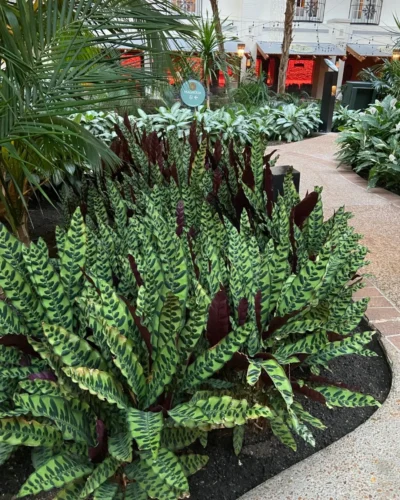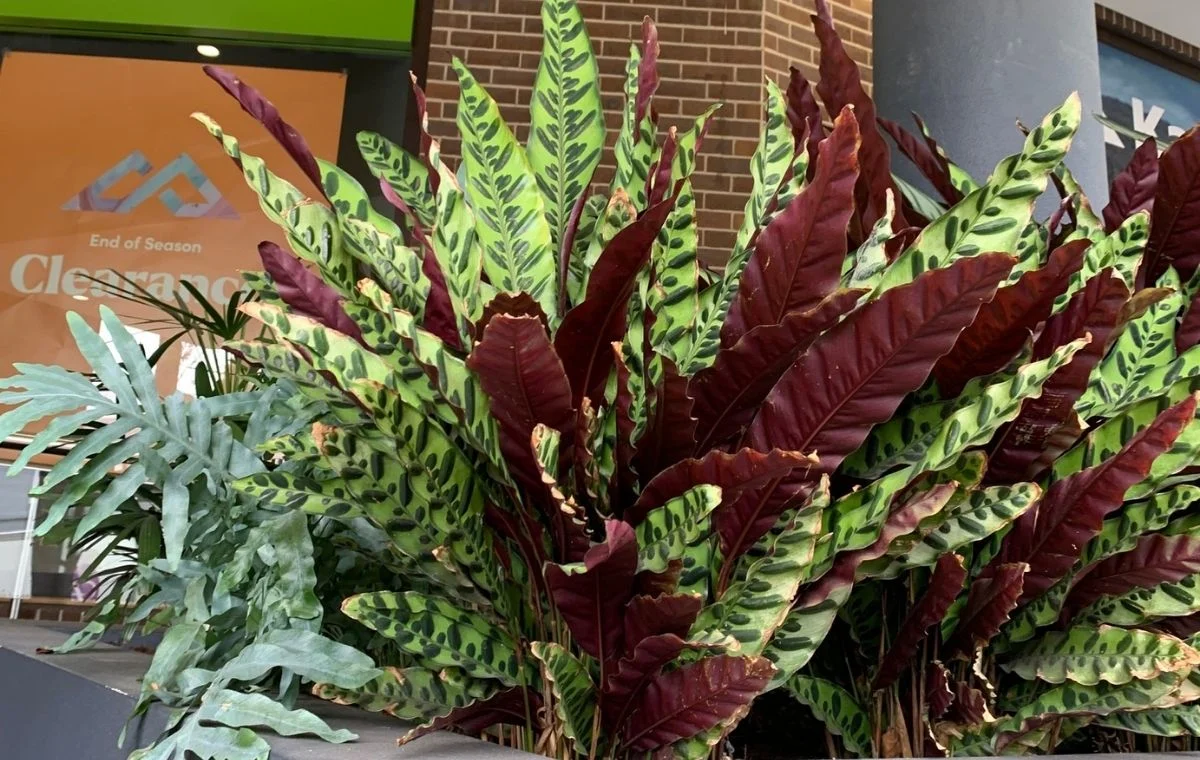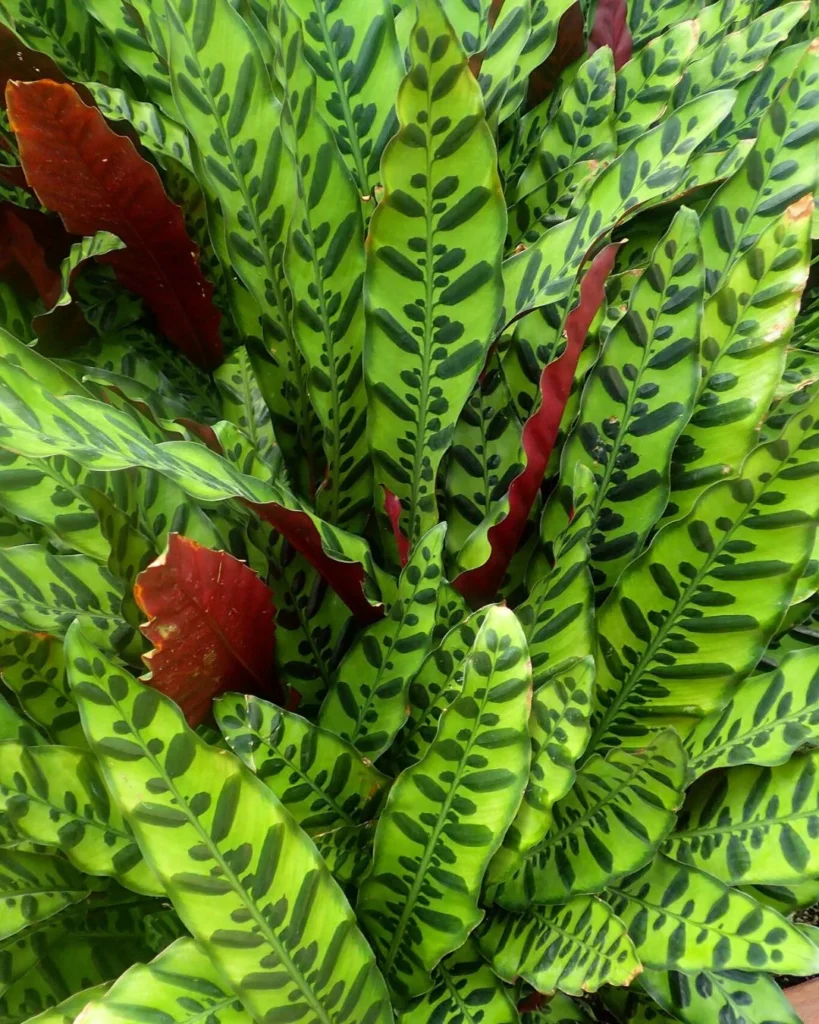The rattlesnake plant (Goeppertia insignis) is a herbaceous, perennial species with distinctively ornamental foliage, so much so that the shades of green on the leaves seem hand-painted. It is a native species of the Atlantic Forest in Rio de Janeiro, Brazil, hence it thrives in a warm and humid climate. Although native to Brazil, the rattlesnake plant has gained global popularity as an ornamental plant, due to its beauty and uniqueness.

It grows in clumps, with long leaves that are slightly wavy at the edges, leathery, erect, and sword-shaped, resembling the shape of a rattlesnake’s tail. The leaves are light green mixed with dark green, while the underside is a purplish color, making this species’ foliage a true natural print.
Like other plants in the Marantaceae family, the rattlesnake plant exhibits nyctinastic behavior, characterized by the diurnal movement of its leaves. During the day, the leaves extend to maximize sunlight capture for photosynthesis. At night, in a display of movement and beauty, the leaves rise and close. This behavior is an evolutionary adaptation to reduce water loss at night and may also protect the leaves from nocturnal predators and cold.
This movement of the prayer plants reminds us of the gesture of joining hands during a prayer or meditation, hence these plants are also known as ‘prayer plants’. Nyctinasty is the result of changes in water levels in the cells at the base of the leaf, controlled by a circadian rhythm. The flowers of this plant appear in summer, are white or yellow, tubular in shape, and have little ornamental value compared to the foliage. Moreover, they rarely emerge when the plant is cultivated indoors.
The rattlesnake plant, with its distinctly painted leaves, is an exceptional choice for beautifying both indoor spaces and gardens. In landscaping, it can be skillfully used in mass plantings, borders, or as ground cover, creating a hypnotic visual effect with its leaves that change position throughout the day. This plant especially stands out in tropical-style gardens, where its lush foliage complements the luxuriant vegetation, but also adapts well to contemporary gardens, adding a touch of elegance and color. The rattlesnake plant is particularly effective in partial shade areas, where its vibrant colors are enhanced, contrasting harmoniously with the lighter or solid-colored foliage of other plants.

In indoor environments, the rattlesnake plant transforms into a living piece of decor, ideal for living rooms, offices, or any space that benefits from a natural touch. Its large colorful leaves bring life and color, making it a focal point when in pots or planters. The plant can be placed in locations where conventional art would not survive, due to high humidity, such as bathrooms with natural light, making these ideal locations for its needs. By grouping rattlesnake plants with other plants that prefer similar conditions, such as ferns and begonias, a moist microclimate is created that benefits all the plants involved, in addition to providing a much-desired ‘indoor garden’ aesthetic.
It prefers to be grown under abundant diffused light or partial shade, appreciating moist, fertile soils rich in organic matter and well-draining. It is a very hardy plant but requires some basic care such as protecting it from strong sunlight to prevent leaf burn and maintaining soil moisture. In indoor environments, it is also beneficial to maintain a high relative humidity in the air, which favors beautiful leaves. This can be achieved with a sprayer or an electric humidifier. Also, avoid environments with air conditioning.
It does not tolerate temperatures below 59°F (15°C), running a serious risk of burning and dying. Similarly, it is important to space out watering in winter as its metabolism slows down during the cold period. In subtropical to temperate climates, it is advisable to move the plant to indoor environments,
such as a residence or a humid greenhouse, where it is warmer. During the warmer seasons, watering should be regular, possibly accompanied by a small amount of fertilizer to strengthen the plant. Its maintenance involves repotting and pruning, after the winter period, to renew the foliage, the root system, and promote the full development of the plant.
Like other prayer plants, the rattlesnake plant prefers to be watered with chlorine-free, fluoride-free, or salt-free water. Prefer to use organic fertilizers or slow-release ones instead of common soluble fertilizers for the same reason. Multiply the rattlesnake plant by dividing the clumps at the end of spring. Proceed by carefully removing the plant from the pot and gently separating the roots, ensuring that each new section has a good root system and several leaves. Then, replant each division in its own pot with fresh, organic matter-rich, well-draining substrate, maintaining adequate moisture to stimulate new growth.



